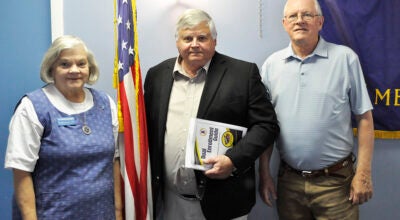Initiative seeks to increase irrigation in Alabama
Published 9:21 am Saturday, January 28, 2012
Renewable water is a tremendous resource in Alabama and has the potential to lessen the gamble farmers take each year when they put crops in the ground, especially for corn producers.
That’s the message Samuel R. Fowler, Ph.D., delivered to the Brundidge Rotarians on Wednesday.
Fowler, the director of the Auburn University Water Resources Center, has been involved in the Alabama Irrigation Initiative since 2008.
Several Pike County farmers were guests of the Brundidge Rotary Club because the Alabama Irrigation Initiative could have a direct impact on the agricultural community.
Fowler told the Rotarians that federal grant dollars are being used to sustain irrigated agriculture in the West.
However, water is becoming a scarce commodity, physically and administratively, and the irrigated West is no longer sustainable.
As water resources tighten in the West, agricultural land will be taken out of production but the demand for agricultural products will continue to be high.
“Crop production could shift to the Southeast where water is abundant,” Fowler said. Alabama uses only 2.5 percent of is renewable water, which is about 33 trillion gallons of surface water, and the ground water supply is about 10 to 14 times as large.
“Most all of the country’s irrigation occurs west of the Mississippi, with 19 percent of the withdrawals coming in California,” Fowler said. “There is no longer enough water to sustain agriculture in the West. Irrigation is not an option for the West.”
Fowler said Western agriculture must go somewhere. That “somewhere” could be South America or it could come East and it could come to Alabama.
In Alabama, the benefits of expanded irrigation are tremendous, Fowler said. “Alabama is in a good position to increase its agricultural products with irrigation. A federally subsidized irrigation project would pay great benefits.”
“With a federally subsidized irrigation project, Alabama would be in a position to compete with dry land production in the West,” Fowler said. “Alabama has six million acres that could be irrigated with one million a strong probability.”
Fowler said the biggest benefit of subsidized irrigation would be in corn production.
“Alabama has an 8.5 billion dollar poultry industry,” he said. “That’s 10 percent of the state’s economy and the poultry industry provides 75,000 jobs.
“Alabama’s poultry industry uses 150 million bushels of corn annually but produces only 30 million bushels.”
If Alabama farmers could supply 120 million more bushels of corn to the state’s poultry industry, that would mean 720 million additional dollars to the economy and an additional 9,000 jobs.
Fowler said the Alabama Irrigation Initiative has the potential to boost the economy, provide additional jobs and keep people on the farm.
“We don’t want Alabama to have to depend on other countries for its food supply,” he said. “That’s why the Alabama Irrigation Initiative is so important.”





